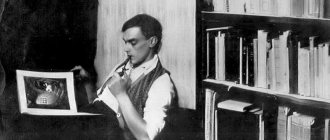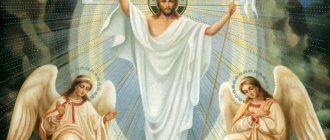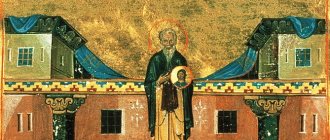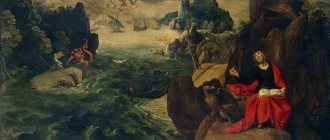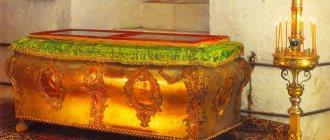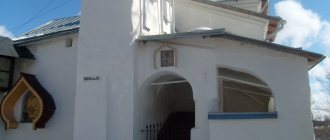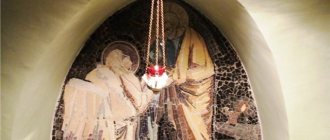According to historical information, the Monk Isaac was born in Syria, but we know almost nothing about the childhood and youth of the Christian ascetic. The Saint himself repeatedly said that his life before the beginning of the hermit’s path was of little importance for his followers, because the main work of the life of Isaac of Dalmatia was serving the Lord.
Many historical testimonies have reached us about the hermit period in the life of the righteous man - thanks to Christian deeds and true piety, Saint Isaac was able to glorify his name for centuries.
Life of Isaac of Dalmatia
Saint Isaac led a hermit's life and spent several decades in the desert before he heard a voice from above commanding him to go to Constantinople. At that time, the capital of Byzantium was engulfed in heretical teachings, the supporters of which were the current emperor Valens.
Venerable Isaac of Dalmatia
Saint Isaac repeatedly asked Valens to renounce false teaching and stop persecuting Orthodox Christians, but the ruler did not want to hear any arguments from the righteous man. He ordered his soldiers to beat Isaac and throw him into the swamp, from which not a single person had previously been able to escape.
However, the ruler did not foresee that the angels would save the righteous man from the fetid mud, and he would again appear before the emperor, without abandoning his intentions to protect Christians from the arbitrariness of the authorities. Then Valens ordered the Saint to be thrown into prison, promising Isaac to deal with him upon his return from the military campaign.
The saint told the ruler that their meeting was not destined to take place, and predicted a terrible death for Valens. This actually happened - the emperor’s army was defeated by the enemy, and the escaped ruler was burned alive in the barn in which he wanted to hide from his pursuers.
Theodosius the Great became the heir to the throne. Immediately after ascending to the throne, he ordered the release of Saint Isaac from prison and received him in the palace with all honors. After participating in the Second Ecumenical Council, the Saint wanted to go to his cell and continue living in the desert, but his disciples begged him not to do this and to remain in Constantinople.
Interesting! Sometimes Isaac himself visited those people who, due to poor health, could not come to him themselves. Repeatedly, the monarch Theodosius invited the righteous man to his palace, where he greeted him with constant honors.
A secluded cell was built for the Saint so that he could spend enough time in prayer, completely devoting himself to communication with God. Despite the fact that the Saint’s cell was located outside the city, many people constantly came there. Ordinary residents of Constantinople came to the Saint every day for advice and instructions, and Saint Isaac did not refuse anyone.
The main work of the life of Isaac of Dalmatia was serving the Lord
Soon, a monastery was erected on the spot where the monk’s cell was originally built. Isaac of Dalmatia lived in it until his death. The saint foresaw the imminent approach of death, so he chose a successor from among his disciples in advance. Immediately after this, the Saint quietly departed to the Lord.
Theodosius the Great was greatly upset by the death of the ascetic and ordered Isaac of Dalmatia to be buried in the Cathedral of Constantinople with great honors. However, Isaac's disciples and simple monks of the monastery knew that the primate was a modest man who did not want pompous celebrations. They begged the ruler to bury the Saint in a church located not far from the monastery in which the righteous man lived. So Isaac of Dalmatia was buried in the altar of the Church of St. Stephen.
Saint's Cathedral
One of the most important is the Cathedral of St. Isaac of Dalmatia in St. Petersburg. It amazes with its beauty and versatility. More than once there have been disputes around it over whether it should be classified as a religious building or a museum. Most art historians consider it unique in its structure.
The best article for you, go to: Icon “Assuage my sorrows” - what helps
This is practically the only cathedral in Russia in his honor. Initially it was wooden, but later it was rebuilt from stone. It combines interior decoration and a wonderful architectural ensemble. Various finishing stones were used to decorate it. And it’s impossible to take your eyes off the stained glass windows and mosaics.
Those who saw it at least once will never forget its beauty again.
God bless you!
You will also be interested in watching a video story about Saint Isaac:
Image of Saint Isaac
Saint Isaac is especially revered by the Russian Orthodox Church; icons depicting this Saint decorate the walls of many churches and are often found in the home iconostases of believers. Even after his death, believers continue to turn to the Saint for help.
Icon of St. Isaac of Dalmatia
Usually on icons Isaac of Dalmatia is depicted as an elderly monk dressed in a dark cassock. The righteous man holds a cross in his right hand, and a scroll in his left. In the Orthodox tradition, there are mainly half-length images of the Saint.
Believers read prayers at the icon of Isaac of Dalmatia in the following cases:
- in search of life purpose;
- asking for guidance on the right path;
- asking for strengthening in faith;
- to make the right decision in a difficult life situation.
When turning to the Saint with a prayer appeal, believers read the following prayer:
Praise to the zealot of Orthodoxy and denouncer of heresy, to the champion of the Church and monks, O Reverend Father Isaac! We flow to you in the tenderness of our hearts and ask for your help for our salvation. You were jealous of the prophet of God Elijah and you fearlessly denounced the evil Tsar: you exhorted him to the knowledge of the Orthodox Faith and you endured reproach and suffering from him, rejoicing. Enlighten us, therefore, with your prayers, to invariably observe the Gospel gospel and resist all heresies, and resist temptations from our many-passionate flesh, from this world and from the devil. Teach us to gather in the temples of God without laziness and bring repentance to the Lord all day long. We believe and hope, servant of God, that the most magnificent church in the country of Russia in our Reigning City was not created in vain in your name by the will of God, but that all Orthodoxy, from all over our country, flowing to this temple, looking at your feat, imitates your faith. Ask then, Reverend Father Isaac, for our Blessed Grand Duchess health and salvation, for victory over adversaries, for the shepherd of the Church for the salvation of the faithful, zeal for all Orthodox Christians in the Faith and prosperity in love, for those who have fallen asleep, blessed repose, so that all this may be received by your prayers Together with you, let us glorify God, wondrous in His saints, in the Trinity, glorified Father and Son and Holy Spirit, now and ever and unto ages of ages. Amen.
Death and burial
Feeling the approach of death, St. Isaac convened his disciples, instructed them in the right faith, and chose one among them, named Dalmatus, whom he appointed as his successor.
After the death of the saint, the emperor ordered a solemn burial with a procession to the church of St. Irene (which was then the cathedral of Constantinople). The brethren of the monastery and the disciples of the saint asked permission to place the remains of Isaac in the church of St. Stephen, built near the Dalmatian monastery. St. Isaac was buried in the altar of this temple, to the right of the holy altar.
Discrepancies in determining the dating of the life of the monk
Based on the text of the Life of Isaac, the year of his death should be considered the 383rd. However, other sources do not confirm this date. According to the Life of Dalmatia, Isaac lived under the archbishop of Attica (406–425). Callinicus, author of the Life of St. Hypatia of Rufinian also reports that St. Isaac was still alive in 406, when he visited St. Hypatia in his monastery. At the same time, another version of the Life of Dalmatia, published by M. Gideon, confirms 383 as the date of the saint’s death, but the publisher himself is critical of the dating of this work, pointing out various inconsistencies found in the text.
Researchers have repeatedly touched upon this issue, and, by all accounts, 383 cannot be considered the year of the saint’s death. Currently, it is generally accepted to date his death to the period after 406. Some researchers more specifically determine the year of death of St. Isaacia. Thus, A. Cameron dates his death to 416 based on data about the Church of the First Martyr. Stephen, in which the relics of Isaac were placed. There is an opinion that the saint died in 424 or 425.
According to O. Meinardus, particles of the relics of St. Isaac and Dalmata are kept in the New Thebaid monastery on Mount Athos.
Veneration of St. Isaac in Russia is associated with the personality of Emperor Peter I, whose birthday (May 30) coincided with the saint’s memorial day. The emperor considered him his heavenly patron, and St. Isaac's Cathedral was erected in St. Petersburg in honor of the saint.
Author:
Tatiana
We publish in the telegram earlier than on the website. Subscribe to the Pravlife Channel
What not to do on June 12, the day of remembrance of St. Isaac the Confessor
June 12 is popularly known as “Snake Day” or the day of Isaac the Serpentine. This is one of the few church holidays when believers are not advised to attend church, but rather pray at home.
Church prohibitions of the day:
1. Swear and sort things out with people. Any bad word on this day is tantamount to a curse, so refrain from any conflict and reconcile those who begin to quarrel.
2. Light fires. It has long been believed that fire on this day can attract evil spirits and demons.
3. Refuse to help those who ask. If you do this, you won't end up in trouble later.
According to popular beliefs, all money and things found on June 12 should be given to a good cause or to someone who needs it. Do not bring the find into the house - it will bring you nothing but misfortunes and troubles.
Prayers
Kontakion, tone 8
'As a faithful saint of God,/ he was kindled with zeal for Christ's Church,/ holding the reins of Valentov,/ prophetically, about the closure of the church, you predicted a disastrous death for the Reverend./ Meanwhile Pray always for us, who honor you, // O Reverend Isaac.
Kontakion St. Isaac, Dalmatus and Favst
(August 3),
tone 2
With forgiveness we will praise the one who has risen like a luminary, / and the heresies that have corrupted through faith, / with songs of praise to Isaac, and with Dalmatus Faustus, / as the saints of Christ, / Him who prayed for everything x us.
Venerable Isaac of Kiev-Pechersk – life
On today (February 27), the Holy Church prayerfully remembers the memory of St. Isaac of Kiev-Pechersk.
Venerable Isaac of Kiev-Pechersk
Reverend Isaac labored in the Kiev-Pechersk Monastery under the leadership of Saint Anthony in the 11th century. He was a great ascetic: he wore prickly, hard and uncomfortable clothes, ate one prosphora a day, and even then not always, and drank small quantities of water. With the blessing of Saint Anthony, Isaac shut himself up in a cramped cave and prayed there to God with tears for seven years, never even lying down on his bed; He slept sitting up and very little.
But the devil, hating virtue, and especially prayerful silence, deceived Isaac and almost completely destroyed him. One day, when he was tired, he put out the candle and sat down to rest. Suddenly the cave was illuminated by a strong light and two demons appeared to the ascetic in the form of beautiful young men. Their faces shone like the sun, and they said: “Isaac! We are angels, but Christ is coming to you with heavenly powers.”
Rising, Isaac saw many luminous demons, but one among them shone more than the others, and rays emanated from his face. Then the demons said to the monk: “Isaac! Here is Christ! Fall down before him and bow to him."
Not understanding the demonic trick and forgetting to cross himself and pray, Isaac bowed to this demon, as if to Christ. Immediately the demons raised a great cry: “Isaac! You are ours now!”
And indeed, having gained power over him, they began to torment the unfortunate man and, leaving him barely alive, disappeared.
The Monk Anthony, and then Theodosius, for a long time and selflessly nursed their student, who suffered from the wiles of the evil one and his own oversight. Isaac was relaxed in mind and body, did not speak or hear anything, and could neither sit nor stand,
nor even turn over to the other side, but lay only on one side, so that worms often appeared under him. The Monk Theodosius washed and straightened him with his own hands. It is amazing that for two years Isaac did not eat or drink anything and still remained alive. Only two years later, on the third, through the prayers of Theodosius, he began to slowly recover, and after the death of Theodosius, under the abbot the Monk Stephen, he began to struggle again and fight the devil.
Over time, he came to an even greater extent than he was before his fall, and was granted many spiritual gifts from the Lord. The demons could no longer harm him in any way and fled from the saint in fear. Finally, the Monk Isaac reposed in Christ, and his incorruptible relics openly rest in the Kiev-Pechersk Monastery to this day.
Spiritual reading >>


